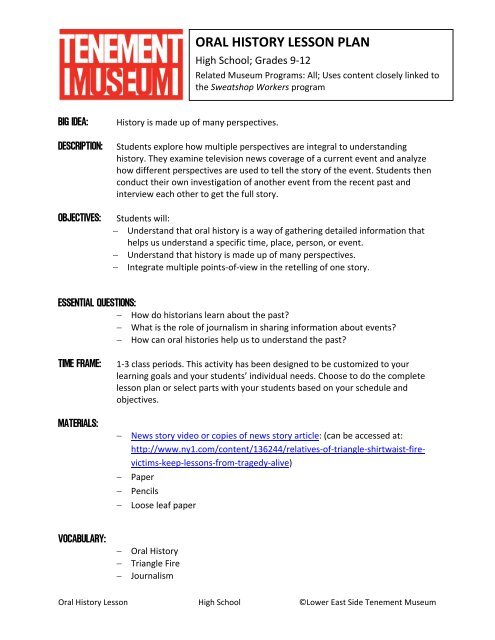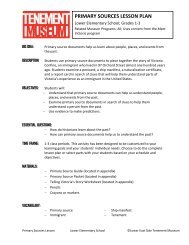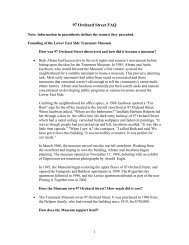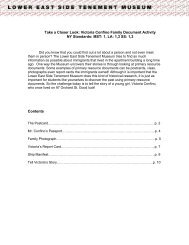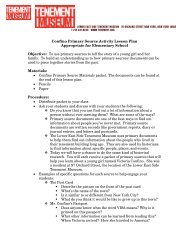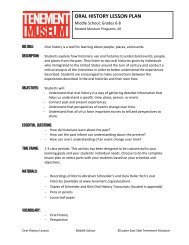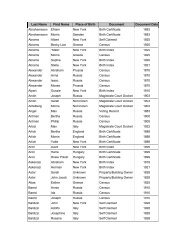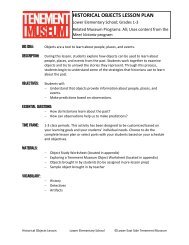ORAL HISTORY LESSON PLAN - Lower East Side Tenement Museum
ORAL HISTORY LESSON PLAN - Lower East Side Tenement Museum
ORAL HISTORY LESSON PLAN - Lower East Side Tenement Museum
Create successful ePaper yourself
Turn your PDF publications into a flip-book with our unique Google optimized e-Paper software.
<strong>ORAL</strong> <strong>HISTORY</strong> <strong>LESSON</strong> <strong>PLAN</strong>High School; Grades 9‐12Related <strong>Museum</strong> Programs: All; Uses content closely linked tothe Sweatshop Workers programBig Idea:Description:Objectives:History is made up of many perspectives.Students explore how multiple perspectives are integral to understandinghistory. They examine television news coverage of a current event and analyzehow different perspectives are used to tell the story of the event. Students thenconduct their own investigation of another event from the recent past andinterview each other to get the full story.Students will:− Understand that oral history is a way of gathering detailed information thathelps us understand a specific time, place, person, or event.− Understand that history is made up of many perspectives.− Integrate multiple points‐of‐view in the retelling of one story.Essential Questions:− How do historians learn about the past?− What is the role of journalism in sharing information about events?− How can oral histories help us to understand the past?Time Frame:Materials:1‐3 class periods. This activity has been designed to be customized to yourlearning goals and your students’ individual needs. Choose to do the completelesson plan or select parts with your students based on your schedule andobjectives.− News story video or copies of news story article: (can be accessed at:http://www.ny1.com/content/136244/relatives‐of‐triangle‐shirtwaist‐firevictims‐keep‐lessons‐from‐tragedy‐alive)− Paper− Pencils− Loose leaf paperVocabulary:− Oral History− Triangle Fire− JournalismOral History Lesson High School ©<strong>Lower</strong> <strong>East</strong> <strong>Side</strong> <strong>Tenement</strong> <strong>Museum</strong>
Procedure:Pre‐Lesson Prep (to be completed before the day of the lesson)− Listen and review the oral history transcripts to become familiar with the material usedin this lesson.Part 1: Introduction− Explain to students that in today’s lesson the class will think about how journalists andhistorians learn about events, people, and places from the past.− Play this news clip or read the news article about the Triangle Factory Fire.− Lead a discussion on how this story from the recent past was told. Guiding questionsmight include:o How many different people helped tell this story?o What did each of those people have to say?o Why did the journalists choose to include all of those perspectives?o What would the story have been like without all of the different people/pointsof‐view?− Explain to students that historians research history in the same way—they collect manydifferent perspectives. When it is possible, these points‐of‐ view are collected throughinterviews. Reinforce that these interviews are referred to as oral histories.Part 2: Activity− Tell students that in today’s lesson they will do the work of historians by researchingand writing about an event from the recent history of the class.− Help students think of an event that they all experienced. Examples include the rise of anew sports star, a current event that made a big headline in the news, or a field trip.− Before the interview process begins, help students brainstorm questions to ask in theirinterviews. Discuss the difference between open‐ended questions and closed (yes‐orno)questions.o Example of close‐ended question: Did you have a nice day?o Example of an open‐ended question: How would you describe your day?− Record students’ suggestions and create a “question bank” from which students can pullquestions.− Explain how the interview process will be set up:o Students will elect 3‐4 classmates to interview.o Students should be selected based on whether or not they offer a uniqueperspective on the event in question.o Those who are interested in being interviewed should give brief explanationsoutlining their point‐of‐view to help the class decide on whom to interview.o The rest of the class will take on the role of reporters/historians.− Give students time to interview one another and remind students to take notes aboutwhat they learn.− Have students compile their research and write an article based on the differentperspectives that they learned about though the interview process.− Ask students to staple their interview notes to back of their articles (to helpdemonstrate process).Oral History Lesson High School ©<strong>Lower</strong> <strong>East</strong> <strong>Side</strong> <strong>Tenement</strong> <strong>Museum</strong>
Part 3: Wrap‐Up− Bring students back together for a wrap‐up discussion. Guiding questions might include:o How did these interviews help you understand the event in question?o What was challenging about the interviewing process?o How would not interviewing “Student X’” have changed your understanding ofthe event?o Have students exchange their articles with a partner in order to get a sense ofhow someone else told the story of the event. Encourage students to commenton those differences and similarities.o What other events and experiences, would the students want to learn aboutusing the oral history method?Assessment:− Observe the interview process.− Review the students’ article and notes.− Note how students incorporate the different perspectives presented by theinterviewees in their work.Extensions:− Examine newspapers from the day after the Triangle Fire on History.com and considerwhat perspectives each paper’s reporting reveals about the event. Visit:http://www.history.com/news/2011/03/24/100‐years‐ago‐the‐triangle‐shirtwaist‐fire/− Have students “publish” their work and create a class newspaper. Students can basetheir articles on the interviews they conducted.− Meet the <strong>Tenement</strong> <strong>Museum</strong>’s oral historians and read an interview about their workon our blog: http://www.tenement.org/blog/?p=193Oral History Lesson High School ©<strong>Lower</strong> <strong>East</strong> <strong>Side</strong> <strong>Tenement</strong> <strong>Museum</strong>
Appendix: Triangle fire factory sheetWhere: The fire occurred on the 8th, 9th, and 10th floors of the Asch Building, a loft building at 23‐29Washington Place, at the corner of Greene Street and just east of Washington Square Park in GreenwichVillage. Loft buildings were a new kind of building. They used steel‐frame construction and electricelevators, so they could be many floors taller than conventional wood‐frame buildings. Although loftbuildings could be used for any commercial purpose, in New York City they were commonly used formanufacturing, especially garment manufacturing. The Asch Building was erected in 1900‐1901. One ofits tenants, the Triangle Shirtwaist Factory, occupied the top three floors.When: The fire broke out just before closing time, 4:40 p.m., on Saturday, March 25th, 1911. The firelasted approximately 15 minutes. Most of the workers on the 8th floor escaped in time. So too did theoccupants of the 10th floor, which was home to the factory’s offices. But no one thought to notify theworkers on the 9th floor. By the time they realized their building was on fire, they were trapped.What: The fire started in a scrap bin on the 8th floor but spread quickly. Garment factories are oftenfilled with inflammable cloth and paper. The air in garment factories may be so thick with garment dust,it too can be set afire. Although the factory owners supplied buckets of water on each floor to put outfires, there weren’t enough to stop a fast‐spreading fire. The building had fire escapes both outside andinside. However, the outside fire escapes were poorly designed and collapsed when too many workerstried to climb down them. One of the internal fire escapes was blocked with smoke and flames from the8th floor. The door to the other fire escape was locked, apparently to stop workers from stealingmerchandise. The slow‐moving elevator took some workers to safety until the remaining workers,desperate to escape the spreading fire, pried open the elevator doors and jumped down the elevatorshaft. So many bodies weighed down the elevator, it couldn’t return to the 9th floor. Finally, workersbegan jumping out windows, choosing death by falling over death by burning.Who: In just a quarter‐hour, 146 people, most of them young Italian and Jewish immigrant women andgirls, died. The factory owners, Max Blanck and Isaac Harris, were put on trial for locking the internalemergency exit, but they were acquitted. In a subsequent civil trial, they were found negligent andforced to pay a fine: $75 ($1,672 in 2010 dollars) for each dead worker. However, their insurancecompany covered the fines, so the owners personally paid nothing. Although Blanck and Harris werewidely reviled for their apparent negligence and indifference, they were, like their workers, hardworkingimmigrants who had worked their way up in the garment industry.Significance: There was no single cause of the fire. The factory owners were certainly negligent inlocking one of the emergency exits, but otherwise they were in full compliance with the city’s and thestate’s fire safety codes. So too was the landlord. A larger cause of the fire was the cut‐throat nature ofthe garment industry. With so many contractors and manufacturers competing for contracts from themajor retailers, factory owners were desperate to cut costs, even at the expense of their workers’safety. Workers were well aware of this issue and had gone on strike in 1909‐1910 to demand, amongother things, improved fire safety standards in the factories. These standards would not become law,however, until after the fire, when the state legislature was shamed into action.Sources: <strong>Lower</strong> <strong>East</strong> <strong>Side</strong> <strong>Tenement</strong> <strong>Museum</strong> Sweatshop Workers tour content, Landmarks Preservation CommissionDesignation List 346 LP-2128 (http://www.nyc.gov/html/lpc/downloads/pdf/reports/brown.pdf); Dave von Drehle’sTriangle: The Fire that Changed America (2004).Oral History Lesson High School ©<strong>Lower</strong> <strong>East</strong> <strong>Side</strong> <strong>Tenement</strong> <strong>Museum</strong>


